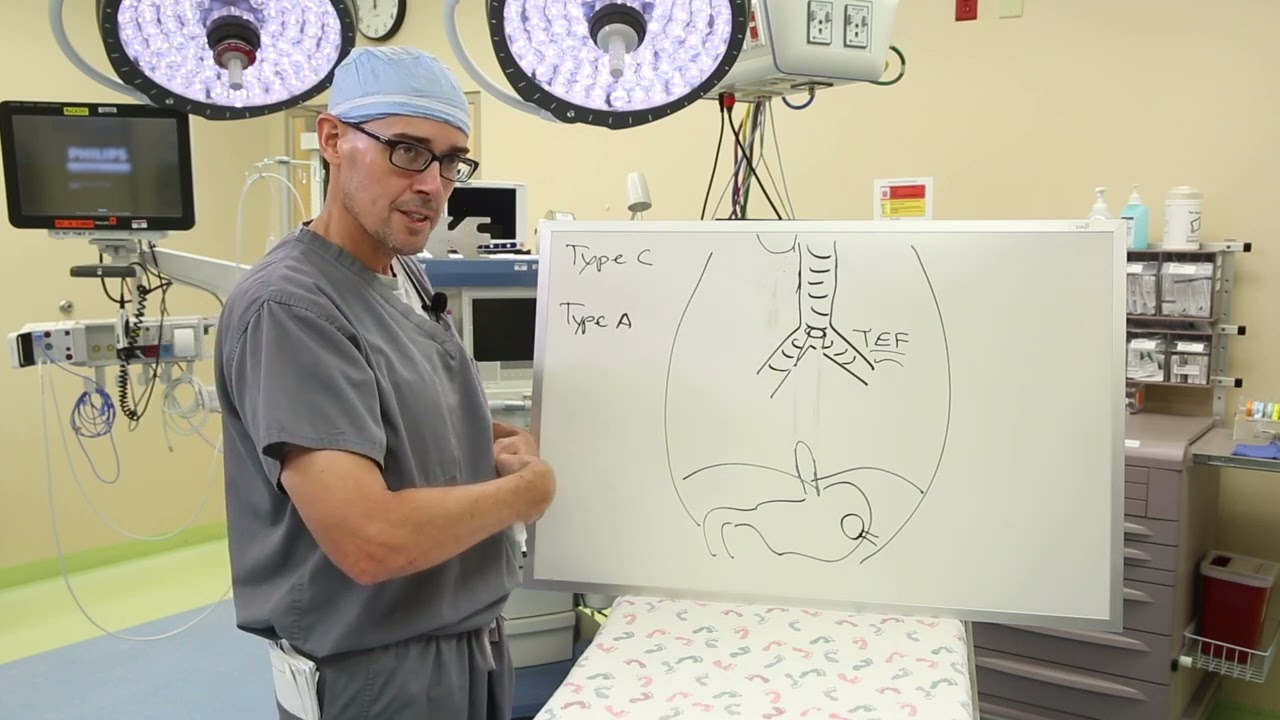Esophageal Atresia Care
Expert diagnosis and treatment for children with all types of esophageal atresia
For children with esophageal atresia the Esophageal and Airway Treatment team at Johns Hopkins All Children’s Hospital in St. Petersburg, Florida, provides expert diagnosis and advanced surgical treatment. Led by esophageal and airway expert Jason Smithers, M.D., the team has the experience to provide your child with the advanced treatment that will best meet their unique needs.
What is Long Gap Esophageal Atresia and how is it treated?
What is esophageal atresia?
Eophageal atresia is a rare congenital (meaning present at birth) defect in which a baby is born without part of the esophagus, causing it to grow in two segments that do not connect.
Our team treats all types of esophageal atresia. There are four main types:
- Type A: The upper and lower segments of the esophagus both end in a pouch. Type A does not include tracheoesophageal fistula (TEF), which is an abnormal connection between the trachea and esophagus that can allow swallowed food or liquids into the lungs.
- Type B: The lower segment ends in a pouch, and the upper segment has TEF. This type of esophageal atresia is rare.
- Type C: The upper segment ends in a pouch, and the lower segment has TEF. This is the most common type of esophageal atresia.
- Type D: Both the upper and lower segments have TEF. This type of esophageal atresia is the rarest.
- Type E: TEF only
- Type F: Congenital stricture
Esophageal atresia may be associated with VACTERL syndrome. VACTERL syndrome is when a group of congenital defects occur together. These defects may include vertebral defects, anal atresia, cardiac defects, tracheoesophageal fistula, renal anomalies and limb abnormalities.
How is esophageal atresia diagnosed?
Esophageal atresia is usually diagnosed after birth. Symptoms can include coughing, choking or a baby turning blue when trying to feed. Physicians may also be unable to pass a feeding tube through the baby’s nose or mouth into their stomach due to the missing portion of the esophagus. An X-ray is used to confirm a diagnosis of esophageal atresia.
Another sign of esophageal atresia is “absent stomach,” in which there is no air in the stomach, or too much amniotic fluid. Both may be seen on an ultrasound before birth so it may in rare cases be diagnosed before birth, particularly if other birth defects are present, but the majority of cases are not detected until after birth.
How is esophageal atresia treated?
There are different types of surgical treatment for esophageal atresia depending on your child’s individual condition, including how much of the esophagus is missing. In some cases, so much of the esophagus is missing that the ends can’t be easily connected. This is called long gap.
Procedures we perform to treat esophageal atresia include:
Primary anastomosis: This is done to connect the two ends of the esophagus in one surgery, when the gap is short enough.
Foker procedure: Our team has expertise in using the Foker procedure to treat esophageal atresia in babies younger than 1 year of age. The Foker procedure is done to stimulate the ends of the esophagus to grow so that it can be connected directly.
Jejunal interposition: This procedure replaces the esophagus with the small intestine and is done for children who may have had a previous attempts at repair and continue to struggle with esophageal issues that cannot be fixed with another procedure.
Follow-up care
After surgery, children are typically seen by our team every three months during the first year of life, then annually until age 5. After that, patients are generally seen every two to three years.
As part of your child’s follow-up care, they will receive routine esophageal scope and biopsy to monitor for any cellular changes related to reflux. This allows us to be proactive about reflux management, detecting it early so your child can receive proper treatment as needed.
Contact Us
For more information about how our program can help your child or to make an appointment, please call the number below to speak to the program’s nurse coordinator. We serve families throughout the greater Tampa Bay area, across the state of Florida, and beyond.
Give us a call
We know you want what's best for your child. We're ready to assist you with your questions. Call 727-767-3711
Request an Appointment
Complete our online form and our team will reach out to you shortly.


